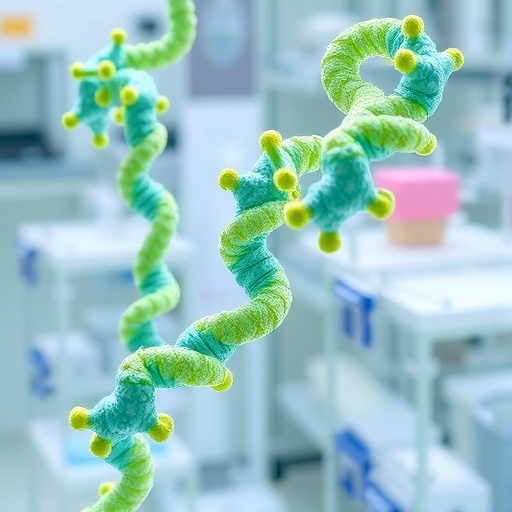In a remarkable breakthrough in the field of biotechnology, researchers from Zhejiang University in China have unveiled a pioneering artificial intelligence model named S²ALM, which stands for Sequence-Structure multi-level pre-trained Antibody Language Model. This innovative model promises to revolutionize antibody design, a critical aspect of therapeutic development, especially as the world continues to grapple with infectious diseases. Antibodies are specialized proteins that play a vital role in the immune response, essentially identifying and neutralizing foreign invaders such as viruses and bacteria. By leveraging this new computational approach, scientists hope to expedite the discovery and optimization of therapeutic antibodies while greatly reducing the time and resources traditionally required for laboratory experimentation.
At the core of S²ALM’s development lies a comprehensive understanding of the intricate relationship between an antibody’s amino acid sequence and its three-dimensional structure. As Professor Tingjun Hou eloquently stated, “The molecular basis of any antibody protein lies in its amino acid sequence. The sequence dictates its 3D structure, which subsequently determines its biological function.” This interplay between sequence and structure has often been overlooked in existing AI models, which predominantly fixate on sequence data alone. S²ALM breaks new ground by integrating both aspects, thus yielding a more nuanced and complete representation of antibody behavior and efficacy.
To train this state-of-the-art model, the researchers utilized an expansive dataset comprising an astonishing 75 million antibody sequences and 11.7 million three-dimensional structural representations. The structures included both results acquired through experimental means and those predicted computationally. This rich dataset enabled S²ALM to develop a deep understanding of the functional and structural paradigms governing antibody interactions, enhancing its predictive capabilities far beyond what has previously been achievable.
The researchers employed an innovative hierarchical pre-training strategy, which comprises two key learning objectives: Sequence-Structure Matching (SSM) and Cross-Level Reconstruction (CLR). SSM allows S²ALM to correlate sequence data with their corresponding structural contexts, effectively bridging the gap between the two. This strategy ensures that the model is not merely correlating patterns but is also capable of understanding the underlying connections that inform an antibody’s binding capacity. On the other hand, CLR empowers the model to foresee and reconstruct missing data by utilizing clues derived from both sequence and structure, enhancing its overall predictive accuracy.
The results of the study revealed that S²ALM significantly outperformed existing AI models across a myriad of essential tasks, including the prediction of antigen-binding capacities, the mapping of B cell maturation processes, and the identification of specific regions on antibodies known as paratopes. Perhaps most impressively, the model demonstrated an uncanny ability to design entirely new antibody sequences that could target formidable pathogens such as the SARS-CoV-2 virus, Ebola, and Influenza B. Such capabilities underscore the potential of S²ALM to not only facilitate the understanding of antibody functions but also expedite the design of effective therapeutic agents.
Researchers reported that the model’s advanced structural predictions revealed that the AI-designed antibodies were capable of forming stable three-dimensional shapes, which are critical for effective interaction with target antigens. This functionality contributes to the antibodies’ efficacy in neutralizing threats, thereby showcasing another layer of S²ALM’s transformative potential in the realm of immune-based therapies. As Professor Jian Wu noted, the success of S²ALM is three-fold; it learns from an extensive database of antibody representations, incorporates intricate structural data with biological features, and exhibits performance that exceeds current standards.
Looking beyond academia, the ramifications of the S²ALM model extend into real-world applications, offering tantalizing prospects for therapeutic innovation. By significantly reducing reliance on conventional trial-and-error laboratory methods, this AI-driven approach stands to streamline the development of next-generation antibodies. Consequently, this progress ushers in a new era of rapid, reliable, and cost-effective immune therapies, marking a profound shift in how we conceptualize and implement antibody research.
Additionally, this remarkable achievement is not occurring in isolation; it forms part of a broader trend where cutting-edge technology, particularly AI and machine learning, is increasingly being harnessed to enhance medical research and pharmaceutical development. As more scientists embrace these computational tools, the pace of discovery and innovation is likely to accelerate, leading to faster solutions for some of humanity’s most pressing health challenges.
Zhejiang University, established in 1897, is a prestigious institution recognized for its commitment to academic excellence and interdisciplinary collaboration. The university’s dedication to advancing scientific inquiry through innovative approaches, such as the S²ALM model, exemplifies its role as a leader in the global research landscape. By cultivating an environment conducive to groundbreaking research, ZJU continues to attract top talent and foster developments that could one day change the trajectory of healthcare and medicine.
With the findings from this study published online in the journal Research on May 12, 2025, S²ALM’s introduction to the scientific community is expected to spark further exploration into antibody design. Researchers worldwide will undoubtedly be motivated to build upon the foundational work achieved by the team at Zhejiang University, potentially leading to even more advanced models and applications in the near future.
In conclusion, the S²ALM model represents a significant leap forward in the field of antibody research and drug development. By elucidating the complex relationships between sequence and structure, it provides researchers with powerful tools to better understand and manipulate one of the immune system’s most vital components. As we venture into a new chapter of biotechnological advancement, there is hope that innovations like S²ALM will lead us closer to effective treatments for an array of diseases, thus improving global health outcomes.
Subject of Research: Antibody Design
Article Title: S2ALM: Sequence-Structure Pre-trained Large Language Model for Comprehensive Antibody Representation Learning
News Publication Date: 19-Aug-2025
Web References: DOI Link
References: N/A
Image Credits: Copyright © 2025 Mingze Yin et al.
Keywords
Antibody Design, S²ALM, Machine Learning, AI in Biotech, Immunology Research




